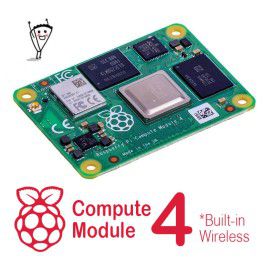Your shopping cart is empty!

5 Ways to Overcome Voltage Supply Challenges on Raspberry Pi
- Ain Zawawi
- 15 Sep 2023
- Protip
- 598
The Raspberry Pi, a versatile and affordable single-board computer, has made significant strides in various industries. From automation and robotics to IoT (Internet of Things) applications, the Raspberry Pi has proven itself as a reliable and cost-effective solution. However, one persistent challenge faced by Raspberry Pi users in the industry is the limited range of supply voltage.
In this post, we'll explore the importance of addressing this issue and suggested solutions to ensure uninterrupted operations in industrial settings.
The Raspberry Pi's compact size, low power consumption, and ability to run various operating systems have made it a preferred choice for industrial applications. It has become a cornerstone in several key industries such as:
- Manufacturing: Raspberry Pi is utilized for process control, monitoring production lines, and managing quality control systems.
Agriculture: It plays a pivotal role in precision agriculture, helping farmers monitor and automate tasks like irrigation, temperature control, and data collection for crop management.
Energy: Raspberry Pi is employed in renewable energy systems to monitor and optimize energy generation and storage.
Healthcare: In the healthcare sector, it is used for data acquisition and analysis, remote patient monitoring, and even as the central processing unit for medical devices.
Transportation: Raspberry Pi is seamlessly integrated into smart transportation systems for real-time data processing, traffic management, and vehicle health monitoring.
Yet, despite these remarkable achievements, we continue to receive feedback and requests on how to extend the supply voltage of Raspberry Pi's nominal supply voltage which is 5V, a standard range for most applications. However, industrial environments often experience power supply fluctuations and disturbances that can exceed or fall below this nominal value. These voltage variations can harm or disrupt the Raspberry Pi, leading to costly downtime and repairs.
Here are some of the strategies used to tackle the supply voltage issue:

Uninterruptible Power Supplies (UPS): Employing UPS units provides an additional layer of protection. UPS systems can deliver stable power to the Raspberry Pi, even during power outages or fluctuations, ensuring continuous operation.
Surge Protection: Industrial environments are susceptible to voltage spikes and surges. Installing surge protection devices safeguards your Raspberry Pi against such events, extending its lifespan and reliability.
Wide-Range Power Supplies: Proactively addressing voltage fluctuations is possible by using power supplies designed to accept a wide input voltage range. These power supplies can accommodate voltage fluctuations without requiring additional voltage regulation.
Redundant Power Supplies: For critical applications, consider implementing redundant power supplies. In case one power source fails, the Raspberry Pi can seamlessly switch to another, minimizing downtime.
Monitoring and Alerts: Employ monitoring systems that can track voltage levels and send alerts when they fall outside a safe range. This allows for proactive maintenance and timely interventions.
The Raspberry Pi's versatility and affordability make it an invaluable tool in various industrial applications. However, the limited range of supply voltage can pose challenges in maintaining its reliable operation. By implementing solutions such as voltage regulators, UPS units, surge protection, wide-range power supplies, and redundant power sources, Raspberry Pi users in the industry can ensure uninterrupted performance even in the face of fluctuating power conditions. Investing in the right power management solutions is crucial to maximizing the Raspberry Pi's potential in industrial settings and reducing costly downtime.
A simple solution
This is where IRIV PiControl steps in. Our latest product is meticulously designed to address these voltage supply challenges and ensure uninterrupted operations in industrial settings. IRIV PiControl comes with the features below:
Wide Operating Voltage Range: IRIV PiControl boasts an impressive range, with the terminal Vin operating between 10-30V and USB C between 4.9-5.2V. Say goodbye to worrying about voltage compatibility.
Built-in Surge Protection: Industrial environments are notorious for voltage spikes and surges. With IRIV PiControl, your electronic equipment is shielded from unwanted power surges or "spikes," extending the lifespan and reliability of your Raspberry Pi.
At Cytron, we understand that choosing the right product for your industry can be a crucial decision. That's why we're here to make the process as worry-free as possible. with our IRIV PiControl Money-back guarantee Program.
Grab this limited offer and invest in the future of your projects, reduce costly downtime, and elevate your industrial applications to new heights. Don't let voltage supply challenges hold you back. IRIV PiControl - Empowering Your Industrial Vision.
Ready to stay informed and get more updates on the industrial product?
Subscribe to our newsletter and secure your front-row seat to the latest industry news, exclusive product updates, and special offers. Don't miss out on valuable insights—get them delivered straight to your inbox.
Related Products
Raspberry Pi CM4 with Wireless - Pick RAM and eMMC
$38.50++ $38.50
IRIV PiControl - IR4.0 CM4 Industrial Controller
$279.00++ $279.00
 International
International Singapore
Singapore Malaysia
Malaysia Thailand
Thailand Vietnam
Vietnam

